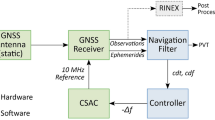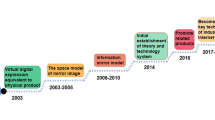Abstract
The aim of quantum metrology is to exploit quantum effects to improve the precision of parameter estimation beyond its classical limit. In this paper, we investigate the quantum parameter estimation problem with multiple channels. It is related but not limited to the following two important and practical quantum metrology problems: (i) Quantum enhanced metrology with control, whose aim is to improve the precision of quantum sensing by utilizing feedback or open-loop control; (ii) Practical quantum metrology where the underlying evolution of quantum probes may change from a unitary dynamics to an open system dynamics, owing to the inevitable decoherence during the quantum sensing operation. For various kinds of quantum multiple channels, the corresponding quantum channel Fisher information is derived. To demonstrate the results, some illustrative examples are given.
Similar content being viewed by others
References
Giovannetti V, Lloyd S, Maccone L. Quantum metrology. Phys Rev Lett, 2006, 96: 010401
Xiang G Y, Higgins B L, Berry D W, et al. Entanglement-enhanced measurement of a completely unknown optical phase. Nat Photon, 2011, 5: 43–47
Napolitano M, Koschorreck M, Dubost B, et al. Interaction-based quantum metrology showing scaling beyond the Heisenberg limit. Nature, 2011, 471: 486–489
Escher B M, de Matos Filho R L, Davidovich L. Quantum metrology for noisy systems. Braz J Phys, 2011, 41: 229–247
Demkowicz-Dobrzański R, Kolodyński J, Guţă M. The elusive Heisenberg limit in quantum-enhanced metrology. Nat Commun, 2012, 3: 1063
Kolodyński J, Demkowicz-Dobrzański R. Efficient tools for quantum metrology with uncorrelated noise. New J Phys, 2013, 15: 073043
Escher B M, de Matos Filho R L, Davidovich L. General framework for estimating the ultimate precision limit in noisy quantum-enhanced metrology. Nat Phys, 2011, 7: 406–411
Alipour S, Mehboudi M, Rezakhani A T. Quantum metrology in open systems: dissipative Cramér-Rao bound. Phys Rev Lett, 2014, 112: 120405
Liu Z P, Zhang J, Özdemir K, et al. Metrology with PT-symmetric cavities: enhanced sensitivity near the PT-phase transition. Phys Rev Lett, 2016, 117: 110802
Hou Z B, Zhu H J, Xiang G Y, et al. Achieving quantum precision limit in adaptive qubit state tomography. npj Quantum Inf, 2016, 2: 16001
Zhang J, Peng B, (Özdemir K, et al. A phonon laser operating at an exceptional point. Nat Photon, 2018, 12: 479–484
Wang Y L, Dong D Y, Qi B, et al. A quantum hamiltonian identification algorithm: computational complexity and error analysis. IEEE Trans Autom Control, 2018, 63: 1388–1403
Yokoyama S, Pozza N D, Serikawa T, et al. Characterization of entangling properties of quantum measurement via two-mode quantum detector tomography using coherent state probes. Opt Express, 2019, 27: 34416–34432
Wang Y L, Yin Q, Dong D Y, et al. Quantum gate identification: error analysis, numerical results and optical experiment. Automatica, 2019, 101: 269–279
Hou Z, Wang R J, Tang J F, et al. Control-enhanced sequential scheme for general quantum parameter estimation at the Heisenberg limit. Phys Rev Lett, 2019, 123: 040501
Song Q J, Huang Z Y. Identification of errors-in-variables systems with general nonlinear output observations and with ARMA observation noises. J Syst Sci Complex, 2020, 33: 1–14
Hou Z B, Zhang Z, Xiang G Y, et al. Minimal tradeoff and ultimate precision limit of multiparameter quantum magnetometry under the parallel scheme. Phys Rev Lett, 2020, 125: 020501
Hou Z B, Tang J F, Ferrie C, et al. Experimental realization of self-guided quantum process tomography. Phys Rev A, 2020, 101: 022317
Wang Y L, Dong D Y, Sone A, et al. Quantum Hamiltonian identifiability via a similarity transformation approach and beyond. IEEE Trans Autom Control, 2020, 65: 4632–4647
Yu Q, Wang Y L, Dong D Y, et al. On the capability of a class of quantum sensor. 2020. ArXiv:2003.08679
Liu L Q, Yuan H D. Achieving higher precision in quantum parameter estimation with feedback controls. Phys Rev A, 2020, 102: 012208
Roy S M, Braunstein S L. Exponentially enhanced quantum metrology. Phys Rev Lett, 2008, 100: 220501
Anisimov P M, Raterman G M, Chiruvelli A, et al. Quantum metrology with two-mode squeezed vacuum: parity detection beats the Heisenberg limit. Phys Rev Lett, 2010, 104: 103602
Chaves R, Brask J B, Markiewicz M, et al. Noisy metrology beyond the standard quantum limit. Phys Rev Lett, 2013, 111: 120401
Demkowicz-Dobrzański R, Maccone L. Using entanglement against noise in quantum metrology. Phys Rev Lett, 2014, 113: 250801
Yuan H. Sequential feedback scheme outperforms the parallel scheme for Hamiltonian parameter estimation. Phys Rev Lett, 2016, 117: 160801
Giovannetti V. Quantum-enhanced measurements: beating the standard quantum limit. Science, 2004, 306: 1330–1336
Choi S, Sundaram B. Bose-einstein condensate as a nonlinear Ramsey interferometer operating beyond the Heisenberg limit. Phys Rev A, 2008, 77: 053613
Giovannetti V, Lloyd S, Maccone L. Advances in quantum metrology. Nat Photon, 2011, 5: 222–229
Yuan H D, Fung C H F. Optimal feedback scheme and universal time scaling for Hamiltonian parameter estimation. Phys Rev Lett, 2015, 115: 110401
Liu J, Yuan H D. Quantum parameter estimation with optimal control. Phys Rev A, 2017, 96: 012117
Pang S, Jordan A N. Optimal adaptive control for quantum metrology with time-dependent Hamiltonians. Nat Commun, 2017, 8: 14695
Matsuzaki Y, Benjamin S, Nakayama S, et al. Quantum metrology beyond the classical limit under the effect of dephasing. Phys Rev Lett, 2018, 120: 140501
Wang K K, Wang X P, Zhan X, et al. Entanglement-enhanced quantum metrology in a noisy environment. Phys Rev A, 2018, 97: 042112
Chen Y, Yuan H D. Cooperation between coherent controls and noises in quantum metrology. 2018. ArXiv:1801.07563v1
Zhou S S, Zhang M Z, Preskill J, et al. Achieving the Heisenberg limit in quantum metrology using quantum error correction. Nat Commun, 2018, 9: 78
Liu L J, Cheng S M, Qi B, et al. Precision limit of atomic magnetometers in the presence of spin-destruction collisions. J Phys B-At Mol Opt Phys, 2015, 48: 035502
Liu L J, Qi B, Cheng S M, et al. High precision estimation of inertial rotation via the extended Kalman filter. Eur Phys J D, 2015, 69: 261
Wu C Z, Qi B, Chen C L, et al. Robust learning control design for quantum unitary transformations. IEEE Trans Cybern, 2017, 47: 4405–4417
Gong B L, Cui W. Multi-objective optimization in quantum parameter estimation. Sci China-Phys Mech Astron, 2018, 61: 040312
Gong B L, Yang Y, Cui W. Quantum parameter estimation via dispersive measurement in circuit QED. Quantum Inf Process, 2018, 17: 301
Dong D Y, Xing X, Ma H L, et al. Learning-based quantum robust control: algorithm, applications, and experiments. IEEE Trans Cybern, 2020, 50: 3581–3593
Liu J, Yuan H D, Lu X M, et al. Quantum Fisher information matrix and multiparameter estimation. 2019. ArXiv:1907.08037
Holevo A. Probabilistic and Statistical Aspects of Quantum Theory. Amsterdam: Edizioni della Normale, 1982
Braunstein S L, Caves C M, Milburn G J. Generalized uncertainty relations: theory, examples, and Lorentz invariance. Ann Phys, 1996, 247: 135–173
Braunstein S L, Caves C M. Statistical distance and the geometry of quantum states. Phys Rev Lett, 1994, 72: 3439–3443
Yuan H D, Fung C H F. Quantum parameter estimation with general dynamics. npj Quantum Inf, 2017, 3: 14
Pang S S, Brun T A. Quantum metrology for a general Hamiltonian parameter. Phys Rev A, 2014, 90: 022117
Anis A, Lvovsky A I. Maximum-likelihood coherent-state quantum process tomography. New J Phys, 2012, 14: 105021
Qi B, Hou Z B, Li L, et al. Quantum state tomography via linear regression estimation. Sci Rep, 2013, 3: 3496
Qi B, Hou Z B, Wang Y L, et al. Adaptive quantum state tomography via linear regression estimation: Theory and two-qubit experiment. npj Quantum Inf, 2017, 3: 19
Yuan H D, Fung C H F. Fidelity and Fisher information on quantum channels. New J Phys, 2017, 19: 113039
Wilcox R M. Exponential operators and parameter differentiation in quantum physics. J Math Phys, 1967, 8: 962–982
Scully M O, Zubairy M S. Quantum Optics. Cambridge: Cambridge University Press, 1997
Zhang X D. Matrix Analysis and Applications. Cambridge: Cambridge University Press, 2017
Liu Y, Cui J X. Realization of Kraus operators and POVM measurements using a duality quantum computer. Chin Sci Bull, 2014, 59: 2298–2301
Meng X G, Wang J S, Gao H C. Kraus operator-sum solution to the master equation describing the single-mode cavity driven by an oscillating external field in the heat reservoir. Int J Theor Phys, 2016, 55: 3630–3636
Ruan L Z, Dai W H, Win M Z. Adaptive recurrence quantum entanglement distillation for two-Kraus-operator channels. Phys Rev A, 2018, 97: 052332
Acknowledgements
This work was supported by the National Natural Science Foundation of China (Grant Nos. 61773370, 11688101, 61833010, 61828303), and Daoyi DONG also acknowledged the partial support by Australian Research Councils Discovery Projects Funding Scheme (Grant No. DP190101566).
Author information
Authors and Affiliations
Corresponding author
Rights and permissions
About this article
Cite this article
Bao, L., Qi, B., Wang, Y. et al. Multi-channel quantum parameter estimation. Sci. China Inf. Sci. 65, 200505 (2022). https://doi.org/10.1007/s11432-020-3196-x
Received:
Revised:
Accepted:
Published:
DOI: https://doi.org/10.1007/s11432-020-3196-x




